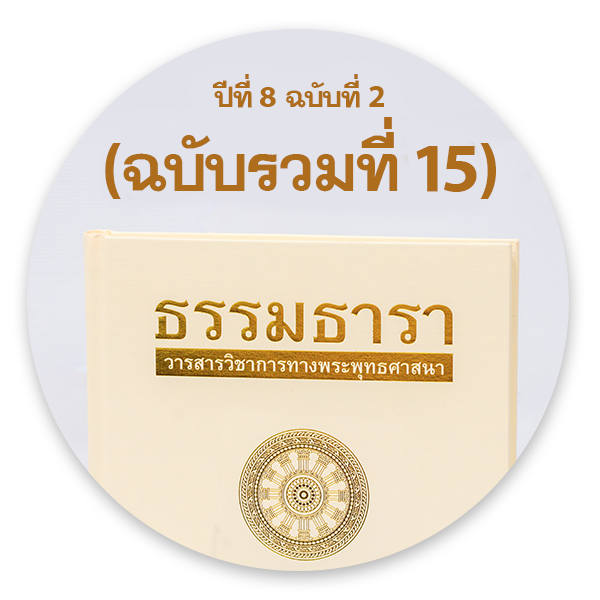Cāturaṅga Sannipāta: The Buddhist Tradition “Māgha Pūjā day” in Thai Society
Main Article Content
Abstract
Cāturaṅga Sannipāta, or the fourfold convention, is one of the important events in the Buddhist narrative. This event happened on Māgha Pūjā Day, which is the 15th day of the waxing moon of the 3rd lunar month and 1,250 Khīnāsava monks, who ordinated with higher ordination by the Buddha (Ehibhikkhu-Upasampadā) and received the Supernatural Knowledge (Abhiññā), gathered without an appointment. Thai Buddhists know about Māgha Pūjā Day from the Royal Merit-Making Ceremony “Māgha Pūjā”. During the reign of King Rama IV, King Mongkut was graciously pleased for this ceremony to be held in the Grand Palace and advocated the general public to likewise observe the event on the 15th day of the waxing moon on the 3rd lunar month.
According to Thailand’s royal writings, “The Twelve-Month Ceremony” of King Chulalongkorn (Reign V) that recorded all ceremonies in the reign of King Mongkut (Reign IV), the Royal Merit-Making Ceremony “Māgha Pūjā”, is the practice of the ancient savants. There is a possibility that these savants may be the commentators to Indians and Sri Lankans because the model from the aforementioned scholar gives information that corresponds to the Dīghanakha Sutta of Majjhimanikāya Commentary, and this points to the propagation of the Cāturaṅga Sannipāta. In addition, the information about Cāturaṅga Sannipāta was also found in the Mahāpadāna Sutta of Dīghanikāya Commentary. When studying the text from these two commentaries, it was found that they were consistent in both the events and the context, but the details of the Cāturaṅga Sannipāta are slightly different. The congruence of these two commentaries can lead to the study of information in the Tipitaka scriptures. However, the Dīghanakha Sutta of Majjhimanikāya Sutta does not appear to show the story of Cāturaṅga Sannipāta. But the Mahāpadāna Sutta of Dīghanikāya is another scripture that may be key to answering the fourfold event in the Tipitaka scriptures.
Article Details

This work is licensed under a Creative Commons Attribution-NonCommercial-ShareAlike 4.0 International License.
ลิขสิทธิ์ สำนักการศึกษา วัดพระธรรมกาย
References
• ภาษาบาลี
---1. คัมภีร์
มหามกุฏราชวิทฺยาลเยน ปกาสิตํ. สฺยามรฏฺสฺส เตปิฎกํ. กรุงเทพมหานคร: โรงพิมพ์มหามกุฏราชวิทยาลัย, 2538.
มหามกุฏราชวิทฺยาลเยน ปกาสิตํ. สฺยามรฏฺสฺส เตปิฏกฏฺกถา. กรุงเทพมหานคร: โรงพิมพ์มหามกุฏราชวิทยาลัย, 2535.
• ภาษาไทย
---1. คัมภีร์
มหาจุฬาลงกรณราชวิทยาลัย. พระไตรปิฎกฉบับภาษาไทย ฉบับมหาจุฬาลงกรณราชวิทยาลัย. กรุงเทพมหานคร: โรงพิมพ์มหาจุฬาลงกรณราชวิทยาลัย, 2539.
มหามกุฏราชวิทยาลัย. พระไตรปิฎกและอรรถกถา แปล ชุด 91 เล่ม. (พิมพ์ครั้งที่ 6) กรุงเทพมหานคร: โรงพิมพ์มหามกุฏราชวิทยาลัย, 2555.
---2. หนังสือ
กรมการศาสนา กระทรวงวัฒนธรรม. เอกสารประชาสัมพันธ์งานสัปดาห์ส่งเสริมพระพุทธศาสนาเนื่องในเทศกาลมาฆบูชา ประจำปี 2561. โรงพิมพ์อักษรไทย: กรุงเทพมหานคร, 2561.
พัฒน์ เพ็งผลา. บาลีสันสกฤตในภาษาไทย. กรุงเทพมหานคร: โรงพิมพ์มหาวิทยาลัยรามคำแหง, 2541.
พระจุลจอมเกล้าเจ้าอยู่หัว. พระราชพิธีสิบสองเดือน. กรุงเทพมหานคร: โรงพิมพ์ไทย ถนนรองเมือง, 2463.
พระพรหมคุณาภรณ์ (ประยุทธ์). วันสำคัญของชาวพุทธไทย. มูลนิธิการศึกษาเพื่อสันติภาพ พระธรรมปิฎก (ป.อ. ปยุตฺโต): ม.ป.พ., 2556. https://www.watnyanaves.net/uploads/File/books/pdf/important_buddhist_days_in_thailand.pdf.
สมเด็จพระเจ้าบรมวงศ์เธอ กรมพระยาวชิรญาณวโรรส. พุทธประวัติ เล่ม 1. ม.ป.ท.: โรงพิมพ์บำรุงนุกูลกิจ, 2455.
สมเด็จพระมหาสมณเจ้า กรมพระยาวชิรญาณวโรรส. พุทธประวัติ มัชฌิมโพธิกาล (พุทธประวัติ เล่ม 2). ม.ป.ท.: โรงพิมพ์มหามกุฏราชวิทยาลัย, 2493.
สุรสิทร์ ไชยรัตน์. คัมภีร์ใบลานในประเทศไทย. กรุงเทพมหานคร: โรงพิมพ์มหาจุฬาลงกรณราชวิทยาลัย, 2556.
---3. บทความ
เด่นพงษ์ แสนคำ และอัครยา สังขจันทร์. “บทวิเคราะห์รัฐไทยกับการปฏิรูปพุทธศาสนาในสมัย ร.4 และ ร.5.” วารสารรัฐศาสตร์และรัฐประศาสนศาสตร์, ปีที่ 11, ฉบับที่ 1, (มกราคม-มิถุนายน 2563): 141-170.
นพดล ปรางค์ทอง. “‘จาตุรงคสันนิบาต’ ในพระไตรปิฎก และการแสดงโอวาทปาติโมกข์ในสมัยพระโคดมพุทธเจ้า.” วารสารวิชาการคณะมนุษยศาสตร์และสังคมศาสตร์มหาวิทยาลัยราชภัฏนครสวรรค์, ปีที่ 7, ฉบับที่ 1, (มกราคม-มิถุนายน 2563): 89-97.
พิเศษ ปิ่นเกตุ. “ความสืบเนื่องของพระราชพิธีในกฎมณเฑียรบาลสมัยอยุธยาจนถึงสมัยรัตนโกสินทร์.” วารสารวิชาการอยุธยาศึกษา, ปีที่ 12, ฉบับที่ 1, (มกราคม-มิถุนายน 2563): 7-22.
สาโรจน์ บัวพันธุ์งาม. “การกลายเสียงสระของคำยืมภาษาบาลีและสันสกฤตในภาษาไทย.” วารสารดำรงวิชาการ, ปีที่ 16, ฉบับที่ 1, (มกราคม-มิถุนายน 2560): 147-174.
อาทิตย์ ศรีจันทร์. “พระราชพิธีสิบสองเดือน: อรรถกถาธิบายแห่งความศิวิไลซ์และการจัดระเบียบจักรวาลวิทยาแบบสมัยใหม่ในพระราชพิธีของสยาม.” วารสารรัฐศาสตร์ปริทรรศน์ มหาวิทยาลัยเกษตรศาสตร์, ปีที่ 1, ฉบับที่ 2, (กรกฎาคม-ธันวาคม 2557):149-184.
---4. วิทยานิพนธ์
โดม ไกรปกรณ์. “ตำราพระราชพิธีสมัยรัชกาลที่ 4-5 (พ.ศ. 2394-2453).” วิทยานิพนธ์ปริญญามหาบัณฑิต, บัณฑิตวิทยาลัย คณะศิลปศาสตร์ มหาวิทยาลัยธรรมศาสตร์, 2542.
ณัฐกานต์ บุญยะดาษ. “การศึกษาพิธีกรรมทางพระพุทธศาสนาในพระราชนิพนธ์เรื่องพระราชพิธีสิบสองเดือน.” วิทยานิพนธ์ปริญญามหาบัณฑิต, บัณฑิตวิทยาลัย มหาวิทยาลัยมหาจุฬาลงกรณราชวิทยาลัย, 2559.
พิชัย ยินดีน้อย. “การศึกษาประกาศการพระราชพิธี ในฐานะหลักฐานทางประวัติศาสตร์ไทย (รัชกาลที่ 1-6).” วิทยานิพนธ์ปริญญามหาบัณฑิต, บัณฑิตวิทยาลัย มหาวิทยาลัยศิลปากร, 2555.
---5. ข้อมูลจากเว็บไซต์
วิภัส เลิศรัตนรังษี. “โลกการเมืองในพระราชพิธีสิบสองเดือน,” ACADEMIA, สืบค้นเมื่อ 14 กันยายน 2564. https://www.academia.edu/40804994/_2562_โลกการเมืองในพระราชพิธีสิบสองเดือน.
nakhonsithammarat. “ความรู้เกี่ยวกับการดำเนินงานพระราชพิธี งานรัฐพิธี และงานพิธีต่างๆ.” สืบค้นเมื่อ 10 กุมภาพันธ์ 2565. http://www.nakhonsithammarat.go.th/web_52/datacenter/doc_download/k_ceremory.pdf.
Plookpedia. “ประเพณีหลวงและประเพณีราษฎร์.” true ปลูกปัญญา, 21 เมษายน 2560. https://www.trueplookpanya.com/knowledge/content/57572/-timhis-tim-his-cul-otherknowledge-.
---6. สื่อออนไลน์
ณัชพล ศิริสวัสดิ์. “พุทธศิลป์อินเดียในคติมหายาน อ.ดร.ณัชพล ศิริสวัสดิ์ Ep1.” วิดีโอยูทูป Chedha Tingsanchali, เผยแพร่เมื่อ 2 มีนาคม 2564, 13:25-14:10. https://www.youtube.com/watch?v=mTXXqkMwMDo.
พระครูปลัดสุวัฒนโพธิคุณ (สมชาย), “ไขข้อสงสัย ครั้งที่ 30 | 09-10-64 | ThanavuddhostoryOfficial,” วิดีโอยูทูป พระมหาสมชาย ฐานวุฑฺโฒ ThanavuddhoStoryOfficial, เผยแพร่เมื่อ 9 ตุลาคม 2564, 15:15-18:10. https://www.youtube.com/watch?v=vh4NqLej5Lo.
• ภาษาต่างประเทศ
---1. หนังสือ
Warder, A.K.. Indian Buddhism. Delhi: Motilal Banarsidass Publishers, 2000.
---2. พจนานุกรม
Davids, T.W. Rhys and William Stede. The Pali Text Society’s Pali-English Dictionary. The Pali Text Society, 1921-1925.
---3. บทความภาษาอังกฤษ
von Hinüber, Oskar. “Building the Theravada Commentaries Buddhaghosa and Dhammapala as Authors, Compilers, Redactors, Editors and Critics.” Journal of the International Association of Buddhist Studies, Vol 36/37, (2013/2014): 355-364.
---4. ข้อมูลจากเว็บไซต์
“Magha Puja Day.” translate by Thanapol Chadchiadee and Marco Roncarati, Ministry of Culture, 23 August 2015. https://www.m-culture.go.th/en/article_view.php?nid=29.


